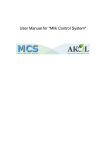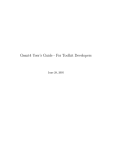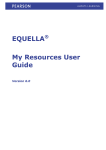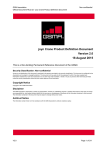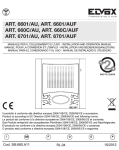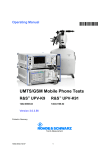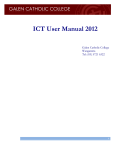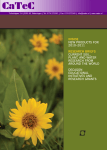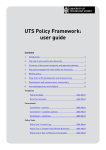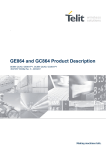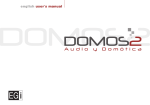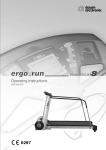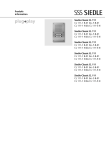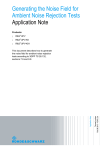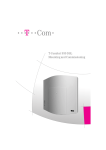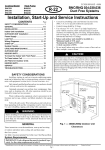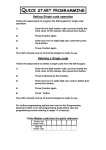Download 79/374/NP - ISO/IEC JTC1 SC25 WG1 Home Page
Transcript
79/374/NP NEW WORK ITEM PROPOSAL ® Proposer Date of proposal TC/SC Secretariat Date of circulation Closing date for voting Chinese NC Secretariat 79 2012-03 France 2012-03-23 2012-06-22 A proposal for a new work item within the scope of an existing technical committee or subcommittee shall be submitted to the Central Office. The proposal will be distributed to the P-members of the technical committee or subcommittee for voting on the introduction of it into the work programme, and to the O-members for information. The proposer may be a National Committee of the IEC, the secretariat itself, another technical committee or subcommittee, an organization in liaison, the Standardization Management Board or one of the advisory committees, or the General Secretary. Guidelines for proposing and justifying a new work item are given in ISO/IEC Directives, Part 1, Annex C (see extract overleaf). This form is not to be used for amendments or revisions to existing publications. The proposal (to be completed by the proposer) Title of proposal General Requirements for Building Intercom Systems Standard Scope (as defined in ISO/IEC Directives, Part 2, 6.2.1 ) Technical Specification This international standard specifies the composition, classification, technical requirements, testing methods, inspection rules, packaging, transport & storage of building intercom system. It is the fundamental basis of the design, manufacture and inspection of building intercom systems and equipments. This standard applies to the audio/video intercom systems used in commercial and residential buildings. Purpose and justification, including the market relevance, whether it is a proposed horizontal standard (Guide 108) 1 ) and relationship to Safety (Guide 104), EMC (Guide 107), Environmental aspects (Guide 109) and Quality assurance (Guide 102) . (attach a separate page as annex, if necessary) 1) Marketing relevance: The global demand for intercom system products is around 25 million in 2011, with its market value about 3 billion USD. According to the compound increase rate of 10% per year, it will reach 4.4 billion USD in 2015. In the next decade, video intercom system will be the indispensable household infrastructure. The global applications of intercom system in different areas reveal certain diversity, such as: Asia: China, India, Korea, Japan, and Indonesia: video intercom system for residential quarter is the majority, sharing more than 70% of the global market and maintaining an increase rate of 25% to 30% per year. Latin America: Brazil, Argentina, Chile, and Mexico: video intercom system for single building is the majority. The increase rate is about 20% per year. Europe: U.K, France, Germany, Spain, Turkey, and Netherland: video intercom system for single home is the majority. The increase rate is about 15% per year. Middle East and North America: The market demand for high-end intercom system is fast increasing. China has become one of the fastest growing countries in the global development of the video intercom market. The sales amount of 2011 is about 1.5 billion USD in Chinese market, which is about 50% of the global market share. 2) Necessity: It is very necessary to establish an international standard since the intercom system has played an important role to protect the life and/or property of residents and has become an important part to consist alarming and electronics security protection system. This international standard should be applicable in global scope to cover the different ranges of intercom system in Asia, Europe, America and the other areas. This international standard shall apply to the audio or video intercom systems. Beside the necessary terminologies and definitions, this standard shall include audio and/or video functions and performance requirements, safety requirements, EMC, environments-adapting and stability requirements, as well as relevant testing methods. 3) Feasibility: China issued the Building Intercom Systems standard in 1994 and revised the publication in 2005. The intercom system according to Chinese standard is applicable for residential quarter, high-rise & low-rise buildings, villa and hybrid architecture. That is, the intercom system in accordance with Chinese standard is also able to satisfy the requirements for the global market as well. 1) Most of the famous VDP (video intercom system) manufacturers have been sharing Chinese market, with some of them producing and selling in China for more than 10 years. Over the years of market activities in China, Other TC/SCs are requested to indicate their interest, if any, in this NP to the TC/SC secretary Copyright © 2012 International Electrotechnical Commission, IEC. All rights reserved. It is permitted to download this electronic file, to make a copy and to print out the content for the sole purpose of preparing National Committee positions. You may not copy or "mirror" the file or printed version of the document, or any part of it, for any other purpose without permission in writing from IEC. ® Registered trademark of the International Electrotechnical Commission FORM NP (IEC) 2009-01-09 79/374/NP Chinese standard has gotten comprehensive acceptance by these international manufacturers, and the products in accordance with Chinese standard has been widely used in global scope. For instance, the products from the following manufacturers have already been conformed to the requirements of Chinese Standard. France: Legrand U.S.A.: Honeywell German: TCS, SSS SIEDLE, Bosch Spain: Fermax, Golmar Korea: Samsung, Kocom, Commax Japan: Aiphone Italy: URMET, Elvox, etc. Among them, some of the brands like LEGRAND, ABB, HONEYWELL, URMET and Bosch have their own factories in China. In conclusion, Chinese standard has established a good foundation to prepare an international standard. Available standards on door-phone developed by CLC can be taken into consideration as possible reference. Target date Estimated number of meetings 6 for first CD 2013-12 Frequency of meetings: Proposed working methods Relevant documents to be considered 2 per year E-mail for IS/ TS 2014-12 Date and place of first meeting: 2012-10 Beijing China Collaboration tools N/A Relationship of project to activities of other international bodies N/A Liaison organizations N/A Need for coordination within ISO or IEC N/A Preparatory work Ensure that all copyright issues are identified. Check one of the two following boxes A draft is attached for comment* An outline is attached * Recipients of this document are invited to submit, with their comments, notification of any relevant patent rights of which they are aware and to provide supporting documentation. We nominate a project leader as follows in accordance with ISO/IEC Directives, Part 1, 2.3.4 (name, address, fax and e-mail): Name: Address: Post code: Tel: Fax: Mobile: Email: HE Chengming (Mr.) 65 Sunban South Rd., Jimei North Industrial Zone, Xiamen City, China. 361021 +86 (0)592 6157698 +86 (0)592 6299688 +86 (0)139 0603 5325 [email protected], [email protected] Concerns known patented items (see ISO/IEC Directives, Part 2) Yes. If yes, provide full information as an annex no Name and/or signature of the proposer GUO Chenguang Secretary, Chinese NC of IEC Fax:+86 10 82260660 E-mail:[email protected] Comments and recommendations from the TC/SC officers 1) Work allocation Project team New working group 2) Draft suitable for direct submission as CD CDV/ DTS 3) General quality of the draft (conformity to ISO/IEC Directives, Part 2) Little redrafting needed Substantial redrafting needed 4) Relationship with other activities In IEC Existing working group no: no draft (outline only) In other organizations 5) Proposed horizontal standard 1) Other TC/SCs are requested to indicate their interest, if any, in this NP to the TC/SC secretary. Remarks from the TC/SC officers The TC 79 chairman is in favour of this NWIP. Approval criteria: • • Approval of the work item by a simple majority of the P-members voting; At least 4 P-members in the case of a committee with 16 or fewer P-members, or at least 5 P-members in the case of committees with more than 17 P-members, have nominated or confirmed the name of an expert and approved the new work item proposal. ii 79/374/NP Elements to be clarified when proposing a new work item Title Indicate the subject matter of the proposed new standard or technical specification. Indicate whether it is intended to prepare a standardor a technical specification. Scope Give a clear indication of the coverage of the proposed new work item and, if necessary for clarity, exclusions. Indicate whether the subject proposed relates to one or more of the fields of safety, EMC, the environment or quality assurance. Purpose and justification Give details based on a critical study of the following elements wherever practicable. a) The specific aims and reason for the standardization activity, with particular emphasis on the aspects of standardization to be covered, the problems it is expected to solve or the difficulties it is intended to overcome. b) The main interests that might benefit from or be affected by the activity, such as industry, consumers, trade, governments, distributors. c) Feasibility of the activity: Are there factors that could hinder the successful establishment or general application of the standard? d) Timeliness of the standard to be produced: Is the technology reasonably stabilized? If not, how much time is likely to be available before advances in technology may render the proposed standard outdated? Is the proposed standard required as a basis for the future development of the technology in question? e) Urgency of the activity, considering the needs of the market (industry, consumers, trade, governments etc.) as well as other fields or organizations. Indicate target date and, when a series of standards is proposed, suggest priorities. f) The benefits to be gained by the implementation of the proposed standard; alternatively, the loss or disadvantage(s) if no standard is established within a reasonable time. Data such as product volume of value of trade should be included and quantified. g) If the standardization activity is, or is likely to be, the subject of regulations or to require the harmonization of existing regulations, this should be indicated. If a series of new work items is proposed, the purpose and justification of which is common, a common proposal may be drafted including all elements to be clarified and enumerating the titles and scopes of each individual item. Relevant documents List any known relevant documents (such as standards and regulations), regardless of their source. When the proposer considers that an existing well-established document may be acceptable as a standard (with or without amendments), indicate this with appropriate justification and attach a copy to the proposal. Cooperation and liaison List relevant organizations or bodies with which cooperation and liaison should exist. Preparatory work Indicate the name of the project leader nominated by the proposer. iii 79/374/NP General Requirements for Building Intercom Systems Contents 1 Scope ........................................................................... 5 2 Normative References ............................................................ 5 3 Terms and Definitions ............................................................ 5 4 System Composition and System Classification .................................... 8 5 Technical Requirements .......................................................... 9 6 Testing Methods for Building Intercom Systems ................................... 16 7 Inspection Rules ................................................................ 21 8 Packaging, Transportation and Storage ........................................... 24 Annex A ............................................................................ 26 Annex B ............................................................................ 34 4 79/374/NP General Requirements for Building Intercom Systems 1 Scope This standard sets forth the composition, classification, technical requirements, testing methods, inspection rules, packaging, transportation and storage for building intercom system, and is the fundamental basis of the design, manufacturing and inspection of building intercom system and equipments. This standard is applicable for the audio or video intercom system used for commercial and residential buildings. 2 Normative References The following referenced documents are indispensable of this document for the application. For dated references, only the edition cited applies. For undated references, the latest edition of the referenced document (including any amendments) applies. IEC 60065, Audio, video and similar electronic apparatus - Safety requirements IEC 60529, Degrees of Protection Provided by Enclosures (IP Code) IEC 60950-1, Information technology equipment - Safety - Part 1: General requirements) IEC 62262-2002, Degrees of Protection Provided by Enclosures for Electrical Equipment against External Mechanical Impacts (IK Code) IEC 62599-1, Alarm systems - Part 1: Environmental test methods IEC 62599-2, Alarm systems -- Part 2: Electromagnetic compatibility -- Immunity requirements for components of fire and security alarm systems ITU-T P.51, Artificial Mouth ITU-T P.64, Determination of Sensitivity/Frequency Characteristics of Local Telephone Systems ITU-T P.79, Calculations of Loudness Ratings for Telephone Sets 3 Terms and Definitions The following terms and definitions are applicable for the purposes of this document. 5 79/374/NP 3.1 Audio intercom system An electronic system providing addressing call, intercom and electrical unlocking is used for commercial or residential building(s). 3.2 Video intercom system An electronic system providing addressing call, intercom, video observation and electrical unlocking is used for commercial or residential building(s). 3.3 Audio center manage unit A device installed at the manage centre, which provides both way call, intercom with audio or video outdoor unit and audio or video indoor unit, lock control at audio or video outdoor unit, meanwhile receiving, managing and controlling the information from audio or video outdoor unit and audio or video indoor unit. 3.4 Video center manage unit A device installed at the manage centre, which provides both way call, intercom with video outdoor unit and video indoor unit, lock control at video outdoor unit, surveillance of video outdoor unit, meanwhile receiving, managing and controlling the information from video outdoor unit and video indoor unit. 3.5 Audio outdoor unit A device installed at the building entrance which provides addressing call, intercom, electrical unlocking, and other functions. 3.6 Video outdoor unit A device installed at the building entrance which provides addressing call, intercom, electrical unlocking, video capturing, and other functions. 3.7 Audio indoor unit A device installed inside the user’s room which provides intercom, lock control, and other functions. 3.8 Video indoor unit A device installed inside the user’s room which provides intercom, surveillance, lock control, and other functions. 6 79/374/NP 3.9 System power unit A device supplies power to the system. 3.10 Artificial mouth An analogue device which conforms to the requirements set forth in Article 5 of ITU-T P.51; its sound characteristics are similar to the directivity and radiation pattern of the average human mouth. 3.11 Artificial ear A device being used for calibrating the receiver; it contains an acoustic coupler and a calibrated microphone used for measuring sound pressure. Its overall acoustic impedance within a given frequency band is similar to that of the average human ear; its characteristics conform to the requirements set forth in Article 7 of ITU-T P.64. 3.12 Overall loudness rating (OLR) A measure of the loudness in the entire channel from the reference point of the mouth at the transmitting terminal to the reference point of the ear at the receiving terminal, expressed in dB. [ITU-T P.79 Definition] 3.13 Overall sensitivity The gain of the excitation sound pressure at the reference point of the ear at the reception terminal relative to the reference point of the mouth at the transmitting terminal, expressed in dB; it is a function of frequency. 3.14 Non-linear distortion Distortion of signals at the reception terminal of the system as a result of system non-linearity, expressed as a percentage of the harmonic components of the sound signals at the receiving terminal relative to the fundamental component. 3.15 Channel S/N The sound pressure ratio between signal and background noise at the receiving terminal under excitation of the nominal sound pressure at the transmitting terminal, expressed in dB. 3.16 Sidetone masking rating (STMR) A measure of sidetone loudness after factoring in the masking effects of the human head on sidetone, expressed in dB. [ITU-T P.79 Definition] 7 79/374/NP 3.17 Loudness rating guard-ring position (LRGP) The fixed position for the handle of the indoor unit is used to measure the rating of system loudness. [ITU-T P.64 Definition] 4 System Composition and System Classification 4.1 System Composition A building intercom system basically consists of centre manage unit, outdoor unit, indoor unit, system power supply, central transmission control equipment, etc. 4.2 4.2.1 System Classification Classification by Function By function, building intercom systems are classified into audio intercom system and video intercom system. 4.2.2 Classification by Application By application, building intercom systems are classified into intercom system for villas (mainly for detached houses and villas for single home) are shown in Fig.1, intercom system for general buildings (mainly for general multi-storey flats or offices and apartment mansions) are shown in Fig.2 and intercom system for housing community (mainly for villas, buildings or villas with buildings together) are shown in Fig.3. System power Central transmission control equipment Outdoor unit Indoor unit supply supply Fig. 1 System power Composition of villas Intercom System Indoor unit Central transmission control equipment Indoor unit Indoor unit Central transmission control equipment Indoor unit Outdoor unit Central transmission control equipment Center manage unit 8 79/374/NP Fig. 2 Composition of general buildings Intercom System Central transmission control equipment Villa intercom system Building intercom system Central transmission control equipment Area 1 Central transmission control equipment Center manage unit Central transmission control equipment Central transmission control equipment Villa intercom system Building intercom system Central transmission control equipment Fig. 3 5 Center manage unit Area n Central transmission control equipment Center manage unit Composition of housing community Intercom System Technical Requirements 5.1 5.1.1 Requirements of Appearance and Mechanical Structure Appearance 5.1.1.1 The external dimensions of the enclosure shall conform to the requirements declared by manufacturer. 5.1.1.2 The surface of non-metallic enclosure shall be free of cracks, faded coloring, permanent stains, noticeable deformation or scratches. 5.1.1.3 The surface coating of metallic enclosure shall completely cover the substrate metal and be free of bubbles, corrosion, scratches, peelings, or pores. 5.1.2 Mechanical Structure 5.1.2.1 Buttons and switches shall be operated freely and reliably; parts and components shall be firmly assembled without any looseness. 5.1.2.2 The characteristics of fork springs and the push-button dialing pad shall conform to the requirements of international standards for telephone sets. 5.1.2.3 The wiring terminals of the outdoor unit and the indoor unit after the installation of their connection shall not be exposed to any accessible surface. 5.1.2.4 The enclosure of the outdoor unit shall have protection against physical attack. 5.1.2.5 The enclosure designed for the system power supply shall contain reliable arrangements for the backup power supply. 9 79/374/NP 5.1.3 Marking 5.1.3.1 The devices in the system shall have legible permanent markings. 5.1.3.2 The markings shall contain the following items which are applicable to the device: - The name of the manufacturer or company; - Product plate number or model number; - Serial number or batch number; - Class of protection function; - Date of manufacture; - Power ratings, including regular operating voltage, current and frequency; - Rated current of the circuit protection. If it is impractical to mark the above information on the product, such information shall be provided in the User’s Manual. 5.1.3.3 All handheld control devices shall bear legible markings of their function; characters or numerical digits shall be marked near by the connection terminals; cables shall be numbered, colored or otherwise marked. 5.1.3.4 The markings shall be durable, scrub-resistant, and indelible. 5.1.4 Mechanical Robustness The enclosures of the parts that constitute the system shall be able to withstand a 0.5 J impact on any normally accessible surface. After the impact test, there shall be no permanent deformation or damage. 5.1.5 Enclosure Protection Capability There are three levels of enclosure protection capability: a) Level I The outdoor unit, the system power supply and other outdoor installed parts shall conform to the provisions of IP33 in IEC 60529. After a water pouring test, they shall be able to work normally and conform to the requirements of dielectric strength and insulation resistance. The indoor unit, the system power supply and other indoor installed parts shall conform to the provisions of IP30 in IEC 60529. b) Level II The outdoor unit, the system power supply and other outdoor installed parts shall conform to the provisions of IP53 in IEC 60529. After dust and water pouring tests, they shall be able to work normally and conform to the requirements of dielectric strength and insulation resistance. The indoor unit, the system power supply and other indoor installed parts shall conform to the provisions of IP30 in IEC 60529. C) Level III The outdoor unit, the system power supply and other outdoor installed parts shall conform to the provisions of IP65 in IEC 60529. After dust and water pouring tests, they shall be able to work 10 79/374/NP normally and conform to the requirements of dielectric strength and insulation resistance. The indoor unit, the system power supply and other indoor installed parts shall conform to the provisions of IP30 in IEC 60529. 5.2 5.2.1 Fundamental Functional Requirements Addressing Call Function With operation, the centre mange unit shall be able to call the right outdoor unit or indoor unit, the outdoor unit shall be able to call the right centre manage unit and indoor unit, the indoor unit shall be able to call the right centre manage unit, all shall be able to response with a ring-back tone. 5.2.2 Talking Function With call answered, the system shall enable two-way talking; the voices shall be clear and free of high pitched whistling sound. 5.2.3 Electronic Control Unlocking Function With operation, the centre manage unit and the indoor unit shall be able to control the outdoor unit to perform electrical unlocking. 5.2.4 Nighttime Operability The outdoor unit shall provide proper illumination or visible prompts to facilitate the visitor’s operations at night. 5.3 5.3.1 Acoustic Transmission Characteristics Overall Loudness Rating (OLR) OLR of the outdoor unit: 18 dB±5 dB OLR of the handheld centre manage unit and the handheld indoor unit: 13 dB±5 dB OLR of the hand-free centre manage unit and the hand-free indoor unit: 21 dB±5 dB 5.3.2 Frequency Response The typical curve (dotted line in Fig. 4) and its tolerance (solid line in Fig. 4) of the frequency response from 500 Hz to 3400 Hz for the outdoor unit are shown in Fig.4 The typical curve (dotted line in Fig. 5) and its tolerance (solid line in Fig. 5) of the frequency response from 500 Hz to 3400 Hz for the handheld centre manage unit and the handheld indoor unit are shown in Fig.5 The typical curve (dotted line in Fig. 6) and its tolerance (solid line in Fig. 6) of the frequency response from 500 Hz to 3400 Hz for the hand-free centre manage unit and the hand-free indoor unit are shown in Fig.6 11 79/374/NP Relative sensitivity (dB) 18(dB) Frequency (Hz) Fig. 4 Frequency Response of the Outdoor Unit Relative sensitivity (dB) 14(dB) Frequency (Hz) Fig. 5 Frequency Response of the Handheld Centre Manage Unit and the Handheld Indoor Unit Relative sensitivity (dB) 21(dB) Frequency (Hz) Fig. 6 Frequency Response of the Hand-free Centre Manage Unit And Hand-free Indoor Unit 12 79/374/NP 5.3.3 Non-linear Distortion When the excitation sound pressure is 0 dBPa, the non-linear distortion of the receiving terminal of the system shall not exceed 7%. 5.3.4 S/N Ratio With the handheld centre manage unit and the handheld indoor unit, the channel S/N ratio at the receiving terminal shall not be lower than 30 dB. With the hand-free centre manage unit and the handheld indoor unit, the channel S/N ratio at the receiving terminal shall not be lower than 25 dB. With the outdoor unit, the channel S/N ratio at the receiving terminal shall not be lower than 25 dB. 5.3.5 Sidetone Masking Rating (STMR) Sidetone masking rating value of the handle of handheld centre manage unit and handheld indoor unit shall not be lower than 5 dB. 5.3.6 Ringtone Sound Level In any operation conditions, the ringtone sound level shall be within range of 70 dB (A) and 110 dB (A). 5.4 Video Function Requirements When the video outdoor unit calls the video indoor unit, the video indoor unit shall display the video images captured by the video outdoor unit. The video images shall be of a quality that makes the visitor’s facial features recognizable. 5.5 Image Recording & Replaying Function The system should be equipped with the functions of recording the visitor’s video images into the storage and replaying the visitor’s video images from the storage by indoor unit. 5.6 Video Characteristics 5.6.1 Image Resolution The resolution of black-and-white video images (horizontal center) shall not be lower than 250 TVL. The resolution of color video images (horizontal center) shall not be lower than 200 TVL. 5.6.2 Brightness Discrimination Level The brightness discrimination of black-and-white video images shall not be lower than Level 8. The brightness discrimination of colorized video images shall not be lower than Level 8. 5.6.3 Ambient Illuminance Adaptability The working ambient illuminance of the black-and-white video outdoor unit shall be within the range of 0.1 lux to 4500 lux, and the system’s video function shall operate normally. 13 79/374/NP The working ambient illuminance of the color video outdoor unit shall be within the range of 0.1 lux to 3500 lux, and the system’s video function shall operate normally. 5.7 5.7.1 Power Supply Requirements Power Supply Voltage Adaptability AC: Rating±10% DC: Rating±10%; 12 V power supply preferred. Within the specified range of power supply voltage, the system shall be able to operate normally with no adjustment required. The AC and DC static power consumption of all parts of the system and the capacity of the backup power supply shall be indicated in the User’s Manual. 5.7.2 Power Supply Switching When the main power supply fails due to outage, the system shall be able to automatically switch to the backup power supply. When the main power supply is restored, the system shall be able to switch back to the main power supply. During the switching, the system shall be able to work normally without any misoperation. 5.7.3 Automatic Recharging and Under-voltage Protection 5.7.3.1 The main power supply shall be able to automatically recharge the battery of the backup power supply and conform to the technical requirements of the recharging of the battery. 5.7.3.2 When the battery voltage of the backup power supply drops to the rated threshold of termination, there shall be protections to avoid over-discharge. 5.8 Environmental Adaptability Requirements The working environments of the system are classified into three levels by the degree of harshness. After undergoing all climatic and mechanical environment tests, the system shall be free of any electrical fault, structural deformation, or poor contact. During and after each test, the system’s fundamental basic functions shall all operate normally. 5.9 5.9.1 Safety Requirements Dielectric Strength The dielectric strength between the system’s power plug or the input terminals of the power supply and the metallic exposed parts of the enclosure shall be able to withstand a 45 Hz to 65 Hz AC voltage specified in Table 1. Without any electrical breakdown and electrical arc in one-minute test. Table 1 Dielectric Strength Rated Voltage Uis, (V) DC or Sinusoidal RMS AC Peak Value or Composed Voltage Testing Voltage (kV) 14 79/374/NP 5.9.2 0~60 0~85 0.5 61~125 86~l76 1 126~250 177~354 1.5 25l~500 355~707 2 >500 >707 2Uis+ integral kV number Insulation Resistance The insulation resistance between the system’s power plug or the input terminals of the power supply and the enclosure or the exposed metallic parts of the enclosure shall not be lower than 100 MΩ in normal ambient conditions or 10 MΩ in humid heat conditions. 5.9.3 Leakage Current The system’s leakage current shall not exceed 5 mA (AC, peak value). 5.9.4 Protection under Fault Conditions Under fault conditions which can easily cause damage, no part of the system shall burn and the internal electrical circuit shall be protected to avoid permanent damage. For multi-user systems with more than 28 indoor units under system control, the fault of the partial indoor units shall not affect the normal operations of the other fault-free circuits in the system. 5.9.5 Temperature Rise Under normal working conditions, the temperature of the enclosure of any part of the system shall not exceed 65 ºC, and the temperature of any heat dissipation component inside machine after continuous operating for four hours shall not exceed the specified value of the component. 5.10 Electromagnetic Compatibility Requirements The system shall be able to withstand the harmful effects of the following electromagnetic interference: a) Interference of electrostatic discharge, as specified in IEC 62599-2 gap discharge value 8 KV, contact discharge value 6 KV; b) Interference of radio frequency electromagnetic radiation as specified in IEC 62599-2; c) Interference of electrical fast transient bursts as specified in IEC 62599-2; d) Interference of surge, live wire with neutral wire value 1 KV and live wire or neutral wire with grounding wire of power line value 2 KV, signal wire with grounding wire value 1 KV as specified in IEC 62599-2; e) Interference of 60% reduction of rated voltage and instantly drop voltage to zero from rated voltage as specified in IEC 62599-2. During the test, the system shall be able to work normally without any misoperation in logic control or damage to any component. 5.11 Stability Requirements The functions of the system shall be checked at least three times per day during the system is 15 79/374/NP operating for seven consecutive days in normal climate conditions. During the tests, the system shall be able to work normally without misoperation. 6 Testing Methods for Building Intercom Systems 6.1 6.1.1 General Testing Conditions Ambient Conditions for Tests: Temperature: 15ºC - 35ºC Relative humidity: 25% - 75% Atmospheric pressure: 86 kPa – 106 kPa Unless otherwise stipulated, the ambient noise of the testing venue for the characteristics of acoustic transmission shall not exceed 50 dB(A). 6.1.2 Electrical Connection During the test, system samples shall be installed with the methods recommended by the manufacturer, and all components required for normal operation shall be connected to form a basic unit for system testing. Unless otherwise specified, the system shall be powered by a main power supply (AC) and equipped with backup batteries of a suitable capacity. A basic unit typically consists of an outdoor unit, two indoor units, a set of system power supply, an electronically controlled lock and a transmission line with length of three meters (exclusive of wireless intercom system) connecting the outdoor unit with the indoor units. Moreover, a basic unit shall include all other necessary components specified by the manufacturer (such as an isolator, a layers decoder, and other relay transmission control equipment). Sample configuration shall meet product function requirements. When testing the characteristics of acoustic transmission, the handle of the handheld centre manage unit and the handheld indoor unit shall be fixed on the head-shaped rack in the loudness rating guard-ring position (LRGP). The LRGP shall be determined in accordance with the provisions of ITU-T P.64. The hand-free centre manage unit, the hand-free outdoor unit and the hand-free indoor unit shall be fixed in the centre place of the 0.5 m*0.5 m seamless board, and the device for test should be fixed in the centre of the installation rack. The center of the intersection angle between the artificial mouth and the artificial ear shall be 10 cm right in front of the center of the panel of the enclosure of the outdoor unit. The testing environments shall be in anechoic chamber, and the tested units shall be independently sound proofed in case of interfering with each other. 6.2 Inspection of Appearance and Structure 6.2.1 Inspection of Appearance and Mechanical Structure Use a caliper and other measuring tools to check the product’s exterior dimensions according to 16 79/374/NP which the manufacturer declares; visually inspect the product’s appearance and manually check the control mechanism to make sure that they conform to the requirements set forth in 5.1.1 and 5.12. 6.2.2 Test of Scrub-resistance The scrub-resistance test shall conform to the requirements set forth in 5.1.3. Testing Method: Scrub the markings with a water-dipped cotton ball with strength 50N, and then with a gasoline-soaked cloth for 15 seconds. After the scrubbing, the markings shall not be illegible. 6.2.3 Test of Mechanical Robustness Mechanical Robustness shall be tested in accordance with the methods specified in IEC 62262. The test results shall conform to the requirements set forth in 5.1.4. 6.2.4 Test of Enclosure Protection Capability The degree of enclosure protection capability shall be tested in accordance with the methods specified in IEC 60529. The test results shall conform to the requirements set forth in 5.1.5. 6.3 Inspection of Fundamental Functions Individual parts shall be connected to form a complete system in accordance with the methods specified in 6.1.2. All fundamental functions of the system shall be tested to make sure that they conform to the requirements set forth in 5.2. 6.4 Test of Acoustic Transmission Characteristics See annex A. 6.5 Inspection of Video Characteristics See annex B. 6.6 6.6.1 Test of Power Supply Test of Power Supply Voltage Adaptability 6.6.1.1 Testing Devices and Requirements Test sample with electricity power supply: Obtain an AC voltage regulator, place it between the electricity power supply and the test sample, and connect it to both. Its power capacity shall at least be 100% larger than the rated power of the test sample and be able to produce AC voltage that meets required harshness level. The device used for indicating AC voltage shall have an accuracy of ±0.5%. Test sample with DC power supply by using an adjustable DC regulated voltage supply; its power capacity shall at least be 100% larger than the rated power of the test sample and be able to produce DC voltage that meets required harshness level. The output ripple voltage while working status shall be less than 2/10000 of the output DC voltage. The device used for indicating DC voltage shall have an accuracy of ±5%. 17 79/374/NP The test shall be performed with the test sample at its rated load (or maximum load) and under normal working conditions. Wiring methods and cautions shall be provided in related standards. The related standards shall stipulate that during the test, the test sample shall have no misoperation or fault, and specify the permissible limits of electrical performance and functions when power voltage vary to reach the prescribed values of its harshness level. 6.6.1.2 Testing Procedures Expose the test sample to normal atmospheric conditions, connect an adjustable power supply with a voltage indicator specified in related standards to the power supply input terminals of the sample, power on and keep the sample working at its rated power, and perform tests for electrical performance and functions. Adjust the adjustable power supply according to the prescribed harshness levels to reach the lower limit and the upper limit, and after the test sample reaches its thermal stabilization, perform tests for electrical performance and functions The system sample shall be tested separately under normal, minimum and maximum voltage conditions. Sufficient time shall be allowed to achieve temperature stability. The basic functions of the test sample shall be checked and its power consumption shall be measured. Test results shall conform to the requirements set forth in 5.7.1. 6.6.2 Test of Power Supply Switching Connect and disconnect the AC power supply to the system sample for 10 times, and then check its fundamental functions. The test results shall conform to the requirements set forth in 5.7.2. 6.6.3 Test of Automatic Charging and Under-voltage Protection 6.6.3.1 Measure the charging voltage and current when the main power supply charges the backup power supply. The test results shall conform to the requirements set forth in 5.7.3.1. 6.6.3.2 Discharge the backup power supply until the average voltage of individual batteries reaches the rated termination value, and then measure the current output of the backup power supply. The current output shall not exceed 0.5 mA. 6.7 6.7.1 Test of Environmental Adaptability High Temperature Test Methods specified in IEC 62599-1 shall be followed. The system sample shall remain in a working state throughout the test. The fundamental functions shall be tested during the last half hour of the test. After the test, the system sample shall be allowed to recover for at least one hour. All fundamental functions of the system sample shall be tested. 6.7.2 Low Temperature Test Methods specified in IEC 62599-1shall be followed. The system sample shall remain in a working state throughout the test. The fundamental functions shall be tested during the last half 18 79/374/NP hour of the test. After the test, the system sample shall be allowed to recover for at least one hour. All fundamental functions of the system sample shall be tested. 6.7.3 Constant Humid Heat Test Methods specified in IEC 62599-1 shall be followed. The system shall be powered on at the nominal voltage of power supply, and remain in a working state for 48 hours, after that the system shall be powered off and remain for another 48 hours. Dielectric strength and insulation resistance shall be measured immediately after the test, and the results shall conform to the requirements set forth in 5.9.1 and 5.9.2. After the test, the system sample shall be allowed to recover for at least one hour, then fundamental functions of the system sample shall be tested. Table 3 Level I Description High Temperature Test Low Test Constant Humid Heat Test Test Duration Rating Test Duration Rating Test Duration +55℃±2℃ 16 h +70℃±2℃ 16 h +70℃±2℃ 16 h The indoor unit and system power supply and other parts installed indoors: +55 ℃±2 ℃ 16 h -25 ℃±3 ℃ 16 h -40 ℃±3 ℃ +40 ℃±2 ℃ RH(93±2)% 96 h Sinusoidal accelerated speed Vibration 10 m/ s Test 1 OCT/ m 2 +40 ℃±2 ℃ 96 h RH(93±2)% cycles/direction direction: X,Y,Z accelerated speed 10 m/ s 2 1 OCT/ m +40℃±2℃ 8h 96 h RH(93±2)% 10 Hz~55 Hz, 10 Hz~55 Hz, 20 16 h 16 h The indoor unit and system power supply and other parts installed indoors: -10℃±3℃ 10 Hz~55 Hz, 6.7.4 Level III Rating -10 ℃±3 ℃ Temperature Level II 20 cycles/direction direction: X,Y,Z accelerated speed 10 m/ s 2 1 OCT/ m 20 cycles/direction direction: X,Y,Z Sinusoidal Vibration Test Methods specified in IEC 62599-1 shall be followed. The system sample shall remain in a working state throughout the test. The fundamental functions shall be tested immediately after the test. The exterior and interior of the system sample shall be visually inspected for mechanical damage. See Table 3 for the test parameter settings. The test results shall conform to the requirements set forth in 5.8. 6.8 6.8.1 Safety Test Dielectric Strength and Insulation Resistance Test Test shall be performed according to standard sets forth in Article 10.3 specified in IEC 60065, the test results shall conform to the requirements set forth in Article 5.9.1 and Article 5.9.2. 19 79/374/NP 6.8.2 Leakage Current Test The results of the leakage current test shall conform to the requirements set forth in 5.9.3. Testing Methods: Place the test sample on an insulated table and apply power at 1.1 times the maximum rated voltage until the temperature stabilizes. The reading of the ampere meter could be determined with the measure change-over switch and power switch randomly combined. The internal resistance of the ampere meter is 2 kΩ (including the external resistance in series with the ampere meter). 6.8.3 Fault Protection Test Determine fault conditions possibly resulted with damage according to the system structure and principles. Apply the following fault conditions in the descending of the most convenience: a) Power supply polarity is reversed; b) The output terminal is short-circuited; c) Wiring terminals are wrongly connected each other or in contact with the power supply terminal. d) The secondary winding of the transformer is short-circuited; the primary winding is short-circuited with the secondary winding; if there is an iron core or a shield, each winding is short-circuited with the iron core and the shield. e) For multi-user systems with more than 28 indoor units under control, when the transmission line of the input terminal of any indoor unit is intended short-circuit, or when an indoor unit is resulted fault by the most harshness, test the fundamental functions of other fault-free circuits in the same system. For the above tests, if a fault presents, the test shall last for 2 minutes, and if no fault presents, the test shall last for 4 hours. The test results shall conform to the requirements set forth in 5.9.4. 6.8.4 Temperature Rise Test Test shall be performed according to standard sets forth in 11.2.1 specified in IEC 60065. While the system is in conditions of right operation, the test results shall conform to requirements set forth in Article 5.9.5. , 6.9 6.9.1 Electromagnetic Compatibility Test Electrostatic Discharge Immunity Test The test shall be conducted with methods specified in IEC 62599-2. The test shall cover electrostatic discharge to the positions accessible to the operator and to the reference ground plane with 0.1m distance from the system sample. The test results shall conform to the requirements set forth in 5.10a). Temporary variation less than 200ms is permissible. 20 79/374/NP 6.9.2 Radiated, Radio-frequency, Electromagnetic Field Immunity Test The test shall be conducted with methods specified in IEC 62599-2. The test results shall conform to the requirements set forth in 5.10b). 6.9.3 Electrical Fast Transient/Burst Immunity Test The test shall be conducted with methods specified in IEC 62599-2. The test shall cover impulse interference resulting from the power line and interconnected line. The test results shall conform to the requirements set forth in 5.10c). 6.9.4 Surge Immunity Test The test shall be conducted with methods specified in IEC 62599-2. The test shall cover surges resulting from the power line and interconnected line. The test results shall conform to the requirements set forth in 5.10d). 6.9.5 Voltage Dips and Short Interruptions Immunity Test The test shall be conducted with methods specified in IEC 62599-2. The test results shall conform to the requirements set forth in 5.10e). 6.10 Stability Test The sample passed initial tests shall be kept continuously working for 7 days under normal ambient conditions, its fundamental functions shall be tested at least 3 times per day. The test results shall conform to the requirements set forth in 5.11. 7 7.1 Inspection Rules Inspection Classification The inspection of building intercom systems is classified into the following types: a) Appraising Inspection In any of the following circumstances, an appraising inspection shall be performed: 1) Trial production for new design product or appraisal of product prototype; 2) Production transfer or factory site change; 3) Resumption from obsolete production; 4) Essential modification with structure, material or process which may affect the performance of product; 5) Significant differences between the results of factory delivery inspection and the results of previous appraisal. b) Quality Consistency Inspection Group A Inspection (batch by batch): Full inspection at the time of product delivery; Group B Inspection (batch by batch): Sampling inspection at the time of product delivery; Group C Inspection (cyclic): On a semiannual basis; test samples extracted randomly from 21 79/374/NP conforming batches to be delivered; Group D Inspection (cyclic): On an annual basis; test samples extracted randomly from conforming batches to be delivered. 7.2 Levels of Nonconformance Level I: Nonconforming safety items; Level II: Nonconforming appearance and mechanical structure items; Level III: Nonconforming items other than Levels I and II. 7.3 Test Items and Sequence All the test items, testing methods and technical requirements of building intercom systems, and the classification of nonconformance, shall be in accordance with Table 4. 7.4 Grouping Rules The group of products applies for inspection shall come from the same production batch. Table 4 No. Test Item Quality Consistency Inspection Technical Testing Level of Appraising Requirements Methods Nonconformance Inspection 5.1.1-5.1.2 6.2.1 III √ √ 5.1.3 6.2.2 II √ √ 5.1.4 6.2.3 II √ √ 5.1.5 6.2.4 II √ √ 5.2 6.3 II √ 5.3.1 A.1 II √ Group Group Group Group A B C D Appearance 1 and mechanical structure 2 3 Markings Mechanical Robustness Enclosure 4 protection Capability 5 6 Fundamental functions Overall loudness rating √ √ Table 4(continued) No. 7 8 Test Item Frequency response Non-linear distortion Quality Consistency Inspection Technical Testing Level of Appraising Requirements Methods Nonconformance Inspection 5.3.2 A.2 II √ √ 5.3.3 A.3 II √ √ Group Group Group Group A B C D 22 79/374/NP 9 10 11 12 13 S/N ratio Sidetone masking rating Ringtone sound level Video functions Video characteristics 5.3.4 A.4 II √ √ 5.3.5 A.5 II √ √ 5.3.6 A.6 II √ √ 5.4 B.4 II √ 5.6 B II √ 5.7.1 6.6.1 II √ √ 5.7.2 6.6.2 II √ √ 5.7.3 6.6.3 II √ √ 5.8 6.7 II √ √ 5.9 6.8 I √ √ 5.10 6.9 II √ √ 5.11 6.10 III √ √ √ √ Power supply 14 voltage adaptability 15 Power supply switching Automatic 16 charging & under-voltage protection 17 18 19 20 Environmental adaptability Safety Electromagnetic compatibility Stability 7.5 Sampling Rules 7.5.1 The size of samples submitted for appraising inspection shall be no more than 50 sets and the number of samples to be tested shall be no less than 3 sets. The samples shall be randomly extracted. 7.5.2 Quality Consistency Inspection Group A inspection, all samples shall be inspected. Group B inspection, samples shall be randomly extracted from conforming batch from Group A inspection. The number of samples shall be determined according to the sampling rules for different sample sizes. Groups C and D inspection, samples shall be randomly extracted from conforming batch from Group B inspection, and the samples extracted shall be no less than 3 sets. 7.6 Judgment Rules 7.6.1 Whether a sample is conforming shall be determined in accordance with the test items, testing methods, technical requirements and levels of nonconformance specified in Table 4. If one of the samples is determined to have Level I nonconformance, the entire batch shall be deemed as nonconforming. 23 79/374/NP 7.6.2 Samples for full inspection shall be all conforming. If the quantity of non-conforming samples for sampling inspection is less or equal to the number to determine batch conformance, the batch shall be deemed as conforming; if the quantity of non-conforming samples more than the number to determine batch conformance, the batch shall be deemed as nonconformance; Samples in appraising inspection and Groups C and D inspections shall be all conforming; if one of items is nonconforming, the batch shall be deemed as nonconforming. 7.7 Handling of Nonconformance 7.7.1 Inspection shall be immediately discontinued if Level I nonconformance has resulted in batch nonconformance; in this case, effective corrective actions shall be taken within a relevant scope. The batch shall be resubmitted for inspection after the causes of Level I nonconformance have been eliminated. If the delivered products are involved, users shall be immediately notified so that the products can be returned for repairs; alternatively, repairs can be conducted on the user’s premises. 7.7.2 Nonconforming products from the batch which has been determined to be conforming shall be replaced or repaired to be conforming by the manufacturer. 7.7.3 For batch nonconformance from sampling inspection, inspection shall be discontinued to the products representing that batch, and the causes shall be analyzed. The batch shall be resubmitted for inspection after the causes of nonconformance have been eliminated. 7.8 Resubmission for Inspection of Batches For the nonconforming of batch inspection, after repair, adjustment, analysis of root cause, elimination of the nonconforming causes and full re-inspection with conformance result, the specified quantity of samples shall be randomly extracted again for inspection. If the batch is still nonconforming, the batch should be rejected, and the production should be stopped, until the root causes have been analyzed, measures have been taken to result new appraising inspection passed, then the normal production and quality consistency inspection may be resumed. 8 8.1 Packaging, Transportation and Storage Packaging 8.1.1 The outdoor unit, the indoor unit and the system power supply of building intercom systems and the other accessories shall be separately packaged in carton boxes, and the product part no., quality certificate, warranty certificate, wiring diagram or user’s manual shall be contained inside the box. 8.1.2 Measures shall be taken for vibration-proof, water-proof and damp-proof for the external box of building intercom system kits or the packaging of multiple assembly for transportation. 8.2 Transportation and Storage 8.2.1 The packaging of the products shall be adequate to ensure safety in transport by truck, train, ship or airplane. The packaging for transport shall have measures for vibration-proof, 24 79/374/NP water-proof and damp-proof. 8.2.2 Packaged products shall be stored in a well-ventilated room or warehouse with an ambient temperature of -10℃ to +40℃ and relative humidity of no more than 80% and free of corrosive gas. 25 79/374/NP Annex A (Normative) Test of Acoustic Transmission Characteristics A.1 Test of Overall Loudness Rating (OLR) A.1.1 Test of the OLR of the Outdoor Unit A.1.1.1 Measurement of Sound Pressure Pm at Mouth Reference Point Measurement shall be performed in accordance with Fig. A. 1. Install a standard half-inch sound-pressure microphone in a place 25mm right in front of the lip ring of the artificial mouth in a 90° incidence direction. At the 1000 Hz frequency point, regulate sound pressure Pm at the mouth reference point to -4.7dBPa, then measure sound pressure Pm at all frequency points at an interval of one-third of the octave frequency, so that sound pressure fluctuation within the range of 200 Hz to 4000 Hz will not exceed 1dB (with 1000Hz as the reference point). When the bandwidth is increased to 8000 Hz, sound pressure fluctuation within the extended frequency range of 100 Hz to 8000 Hz shall not exceed the range of +2dB to -5dB. Frequency meter HZ Audio oscillator Artificial mouth 25mm Pm=4.7dB(Relative to 1Pa) Amplifier Equalized sound source AC voltmeter Standard half-inch sound-pressure microphone Fig A. 1 Measurement of Sound Pressure Pm at the Mouth Reference Point A.1.1.2 Measurement of Output Sound Pressure Po of the Outdoor Unit with the Handheld Centre Manage Unit or Handheld Indoor Unit Connected Remove the microphone in Fig. A.1 while keeping the drive sound source of the artificial mouth unchanged, and connect the system in accordance with Fig. A.2. Fix the handle of the handheld centre manage unit or the handheld indoor unit on the head-shaped rack in the LRGP position. Then, vertically fix the outdoor unit in its normal position of installation, and place the standard half-inch sound-pressure microphone in front of the center of the outdoor unit; the microphone shall be 10cm from the center of the enclosure surface of the outdoor unit. Lastly, measure output sound pressure Po of the outdoor unit within the range of 200 Hz to 4000 Hz at all frequency points at an interval of one-third of the octave frequency. 26 79/374/NP Handheld indoor unit/ handheld manage unit Frequency meter HZ Audio oscillator Artificial mouth Speaker amplifier Outdoor unit panel Supporting panel Central Transmission control Receiver equipment amplifier Artificial ear Voltage measuring Measuring device or frequency Spectrum analyzer amplifier 0.5m×0.5m Equalized sound source 10cm Fig. A.2 Measurement of the Acoustic Transmission Characteristics of the Outdoor Unit with the Handheld Centre Manage Unit or the Handheld Indoor Unit Connected A.1.1.3 Measurement of Output Sound Pressure Po of the Outdoor Unit with the Hand-free Centre Manage Unit or the Hand-free Indoor Unit Connected Remove the microphone in Fig. A.1 while keeping the drive sound source of the artificial mouth unchanged, and connect the system in accordance with Fig. A.3. Vertically fix the hand-free indoor unit in its normal position of installation; the lip ring of the artificial mouth shall be 10cm from the center of the hand-free indoor unit. Then, vertically fix the outdoor unit in its normal position of installation, and place the standard half-inch sound-pressure microphone in front of the center of the outdoor unit; the microphone shall be 10 cm from the center of the enclosure surface of the outdoor unit. Lastly, measure output sound pressure Po of the outdoor unit within the range of 200 Hz to 4000 Hz at all frequency points at an interval of one-third of the octave frequency. Frequency meter Outdoor unit panel Hand-free manage unit/hand-free indoor unit Supporting panel Supporting panel HZ Audio oscillator Artificial mouth Equalized sound source 10cm Speaker amplifier Receiver amplifier Artificial ear Measuring amplifier Voltage measuring device or frequency Spectrum analyzer Central transmission control equipment 0.5m×0.5m 0.5m×0.5m 10cm Fig. A.3 Measurement of the Acoustic Transmission Characteristics of the Outdoor Unit with the Hand-free Centre Manage Unit or the Hand-free Indoor Unit Connected A.1.1.4 Calculations for the OLR of the Outdoor Unit Determine overall sensitivity/frequency characteristic Sro of the outdoor unit using Formula (A.1): Sro = 20 lg(Po/ Pm)dB (relative to 1Pa/Pa) …………………………………(A.1) Determine the OLR of the outdoor unit using Formula (A.2): 27 79/374/NP ( S −W ) OLR = − 10 × lg ∑1010 ro oi m i=4 17 m ……………………………… (A.2) where W oi is the weighting coefficient of OLR (see Table A.1 for the Wo of different frequencies), and m is the slope parameter and equals 0.175. The test results shall conform to the requirements set forth in 5.3.1. A.1.2 Test of the OLR of the Centre Manage Unit and the Indoor Unit A.1.2.1 Measurement of Sound Pressure Pm of the Mouth Reference Point The measuring methods and requirements for sound pressure Pm of the reference point of the artificial mouth on the outdoor unit side are the same as those in A.1.1.1. A.1.2.2 Measurement of Sound Pressure Pe of the Earpiece of the Handle of the Handheld Centre Manage Unit and the Handheld Indoor Unit Remove the microphone in Fig. A.1 while keeping the drive sound source of the artificial mouth unchanged, and connect the system in accordance with Fig. A.4. Vertically fix the outdoor unit in its normal position of installation; the lip ring of the artificial mouth shall be 10cm from the center of the outdoor unit. Then, fix the handle of handheld indoor unit on the head-shaped rack in the LRGP position, and tightly couple the earpiece and the artificial ear. Lastly, measure output sound pressure Pe of the earpiece within the range of 200Hz to 4000Hz at all frequency points at an interval of one-third of the octave frequency. Frequency meter Handle of indoor unit Handheld indoor unit/ handheld manage unit Supporting panel Central HZ transmission Artificial Receiver control Speaker ear Artificial mouth Audio oscillator amplifier equipment amplifier Measuring amplifier Voltage measuring device or frequency Spectrum analyzer 0.5m×0.5m Equalized sound source 10cm Fig. A.4 Measurement of the Acoustic Transmission Characteristics of the Calling Channel of the Handheld Centre Manage Unit and the Handheld Indoor Unit A.1.2.3 Measurement of Output Sound Pressure Pe of the Hand-free Centre Manage Unit and the Hand-free Indoor Unit Remove the microphone in Fig. A.1 while keeping the drive sound source of the artificial mouth unchanged, and connect the system in accordance with Fig. A.5. Vertically fix the outdoor unit in its normal position of installation; the lip ring of the artificial mouth shall be 10 cm from the center of the outdoor unit. Then, vertically fix the hand-free centre manage unit or the hand-free indoor unit in its normal position of installation, and place the standard half-inch sound-pressure microphone in front of the center of the indoor unit; the microphone shall be 10 cm from the center of the enclosure surface of 28 79/374/NP the indoor unit. Lastly, measure output sound pressure Pe of the hand-free indoor unit within the range of 200 Hz to 4000 Hz at all frequency points at an interval of one-third of the octave frequency. Frequency meter Handle of indoor unit Hand-free manage unit/hand-free indoor unit Supporting panel Supporting panel HZ Receiver amplifier Speaker amplifier Artificial mouth Audio oscillator Voltage measuring device or frequency Spectrum analyzer Measuring amplifier Artificial ear Central Transmission control equipment Equalized sound source 0.5m×0.5m 0.5m×0.5m 10cm 10cm Fig. A.5 Measurement of the Acoustic Transmission Characteristics of the Hand-free Centre Manage Unit and the Hand-free Indoor Unit A.1.2.4 Calculations for OLR of the Centre Manage Unit and the Indoor Unit Determine overall sensitivity/frequency characteristic Sor of the centre manage unit and the indoor unit using Formula (A.3): Sor = 20 lg(Pe/ Pm) dB (relative to 1Pa/Pa) ……………………………(A.3) Determine the OLR of the centre manage unit and the indoor unit using Formula (A.4): ( S −WOi − LEi ) OLR = − 10 × lg ∑1010 or m i=4 17 m ………………………… (A.4) where LEi is the acoustic leakage coefficient of the earpiece (see Table A.1 for the LE of different frequencies), m is the slope coefficient and equals 0.175. The test results shall conform to the requirements set forth in 5.3.1. Table A.1 Wo and LE of Different Frequencies Frequency Band Central Frequency/Hz Serial No. /I Overall Weighting Earpiece Sound Acoustic Cofficient Wo leakage Coefficient LE 4 200 66.1 8.4 5 250 60.7 4.9 6 315 68.5 1.0 7 400 55.6 -0.7 8 500 66.9 -2.2 9 630 63.3 -2.6 10 800 63.4 -3.2 11 1000 65.3 -2.3 12 1250 73.1 -1.2 13 1600 70.1 -0.1 14 2000 82.0 3.6 29 79/374/NP 15 2500 78.6 7.4 16 3150 95.4 6.7 17 4000 76.9 8.9 A.2 Test of Frequency Response A.2.1 Test of the Frequency Response of the Outdoor Unit Perform measurement in accordance with A.1.1.2 and A.1.1.3. Determine the overall sensitivity / frequency characteristics of the outdoor unit using Formula (A.1). Use 1 kHz as the reference point to record the sound pressure fluctuations of Po relative to Pm. Within the range of 500 Hz t0 3400 Hz, the results shall conform to the requirements set forth in 5.3.2. A.2.2 Test of the Frequency Response of the Centre Manage Unit and the Indoor Unit Perform measurement shall be performed in accordance with A.1.2.2 and A.1.2.3. Determine the overall sensitivity / frequency characteristics of the centre manage unit and the indoor unit using Formula (A.3). Use 1 kHz as the reference point to record the sound pressure fluctuations of Pe relative to Pm. Within the range of 500 Hz t0 3400 Hz, the results shall conform to the requirements set forth in 5.3.2. A.3 Test of Non-linear Distortion A.3.1 Test of Non-linear Distortion of the Outdoor Unit Connect the system sample in accordance with Fig. A.2 or Fig. A.3. Regulate sound pressure Pm of the reference point of the artificial mouth to 0dBPa . The frequency of the drive sound source signals is 500Hz and 1kHz. Fix the handle of the handheld mange unit or handheld indoor unit on the head-shaped rack in the LRGP position. Vertically fix the hand-free centre manage unit or the hand-free indoor unit in its normal position of installation. The lip ring of the artificial mouth shall be 10cm from the center of the hand-free centre manage unit or the hand-free indoor unit. In the place 10cm from the center of the outdoor unit, use a standard half-inch sound-pressure microphone and frequency spectrum analyzer to measure fundamental voltage U1 and second and third harmonic voltage U2 and U3 of the output sound pressure. Determine the non-linear distortion of the outdoor unit, γ , using Formula (A.5): γ = U 22 +U 32 / U1 × 100% …………………………………(A.5) The test results shall conform to the requirements set forth in 5.3.3. A.3.2 Test of Non-linear Distortion of the Centre Manage Unit and the Indoor Unit Connect the system sample in accordance with Fig. A.4 or Fig. A.5. Regulate sound pressure Pm of the reference point of the artificial mouth on the outdoor unit side to 0 dBPa . The frequency of the drive sound source signals is 500 Hz and 1000 Hz, with a distance of 10 cm from the center of the outdoor unit. Tightly couple the earpiece of the handle of the handheld 30 79/374/NP centre manage unit or the handheld indoor unit with the artificial ear, vertically fix the hand-free centre manage unit or the hand-free indoor unit in its normal position of installation, and place the standard half-inch sound-pressure microphone in front of the center of the hand-free centre manage unit or the hand-free indoor unit. The microphone shall be 10 cm from the center of the enclosure surface of the hand-free centre manage unit or the hand-free indoor unit. Use a measuring amplifier and a frequency spectrum analyzer to measure fundamental voltage U1 and second and third harmonic voltage U2 and U3. Determine the non-linear distortion of the centre manage unit and the indoor unit, Formula (A.6): γ= U 22 +U 32 / U1 × 100% γ , using ………………………………… (A.6) The test results shall conform to the requirements set forth in 5.3.3. A.4 Test of S/N Ratio A.4.1 Testing Conditions The test shall be conducted with the conditions of ambient noise ≤40dBA. A.4.2 Test of the S/N Ratio of the Outdoor Unit Connect the system sample in accordance with Fig. A.2 or Fig. A.3. Regulate sound pressure Pm of the reference point of the artificial mouth to -4.7 dBPa, with testing frequency of 1 kHz . Fix the handle of the handheld centre manage unit or the handheld indoor unit on the head-shaped rack in the LRGP position. Vertically fix the hand-free centre manage unit or the hand-free indoor unit in its normal position of installation. The lip ring of the artificial mouth shall be 10 cm from the center of the hand-free centre manage unit or the hand-free indoor unit. In the place 10cm from the center of the outdoor unit, use a standard half-inch sound-pressure microphone to measure the signal sound pressure and the noise sound pressure within the range of 200 Hz to 4000 Hz. The difference in decibels between the signal sound pressure and the noise sound pressure is the S/N ratio of the outdoor unit. The test results shall conform to the requirements set forth in 5.3.4. A.4.3 Test of the S/N Ratio of the Centre Manage Unit and the Indoor Unit Connect the system sample in accordance with Fig. A.4 or Fig. A.5. Regulate sound pressure Pm of the reference point of the artificial mouth on the outdoor unit side to -4.7 dBPa, with testing frequency of 1000 Hz and a distance of 10 cm from the center of the outdoor unit . Tightly couple the earpiece of the handle of the handheld centre manage unit and the handheld indoor unit with the artificial ear. Vertically fix the hand-free centre manage unit or the hand-free indoor unit in its normal position of installation, and place the standard half-inch sound-pressure microphone in front of the center of the hand-free centre manage unit or the hand-free indoor unit, with the microphone being 10 cm from the center of the enclosure surface of the hand-free centre 31 79/374/NP manage unit or the hand-free indoor unit. Measure the signal sound pressure and the noise sound pressure within the range of 200 Hz to 4000 Hz. The difference in decibels between the signal sound pressure and the noise sound pressure is the S/N ratio of the centre manage unit and the indoor unit. The test results shall conform to the requirements set forth in 5.3.4. A.5 Test of the Sidetone Masking Rating (STMR) of the Handheld Centre Manage Unit and the Handheld Indoor Unit Perform measurement in accordance with Fig. A.6, and use the specific testing methods specified in Section 7 of ITU-T P.79. The test results shall conform to the requirements set forth in 5.3.5. Amplifier AC voltmeter Artificial ear Audio oscillator Artificial mouth Speaker amplifier Central Transmission control equipment Indoor handheld unit/manage handheld unit Outdoor unit panel Supporting panel Receiver amplifier 0.5m×0.5m Fig. A.6 Measurement of the STMR of the Handheld Centre Manage Unit and Handheld Indoor Unit A.6 Test of Ringtone Sound Level When the ringtone is sounding, using a sound meter to measure the sound level in the place 0.5m right in front of the central axis of the centre manage unit or the indoor unit with Fig. A.7. Test results shall conform to the requirements set forth in 5.3.6. 0.5m 1.5m Floor 32 79/374/NP Fig. A.7 Test of Ringtone Sound Level 33 79/374/NP Annex B (Normative) Inspection of Video Characteristics B.1 Inspection Methods B.1.1 The inspection for image resolution and brightness discrimination level shall be performed in accordance with Fig.B.1. Adjust the distance between the video outdoor unit and the test pattern to align the borders of image shown on the monitor of the video centre manage unit or the video indoor unit in accordance with the borders specified by test pattern. B.1.2 Test of the ambient illuminance adaptability shall be performed in a dark room. The color temperature of the light source shall be 3100K±100K. Replace the television testing pattern in Fig. B.2 with a human face target for inspection. Monitor Camera Medium transmission control equipment TV testing pattern Video outdoor unit Video indoor unit Fig. B.1 Inspection of Video Characteristics B. 2 Inspection of Image Resolution Use the camera on the video outdoor unit to capture an integrated television testing pattern in Fig. B.2. Observe by visual inspection the maximum number of lines recognizable on the central wedge in the image on the monitor of the video centre manage unit or the video indoor unit. The results shall conform to the requirements set forth in 5.6.1. B.3 Inspection of Brightness Discrimination Level Use the camera on the video outdoor unit to capture a gray level television testing pattern of the integrated television testing pattern in Fig. B.2. Observe by visual inspection the maximum brightness discrimination level recognizable on the monitor of the video centre manage unit or the video indoor unit. The results shall conform to the requirements set forth in 5.6.2. 34 79/374/NP Fig. B.2 Integrated Television Testing Pattern B.4 Inspection of Ambient Illuminance Adaptability Place both the video outdoor unit and the tester in an evenly illuminated environment; adjust the light source to bring ambient illuminance to the minimum and the maximum value; use the camera on the video outdoor unit to capture a facial image of the tester. Observe and evaluate by visual inspection the quality of the image on the monitor of the video centre manage unit or the video indoor unit. At least the facial features of the tester shall be recognizable. The test results shall conform to the requirements set forth in 5.4 and 5.6.3. 35



































